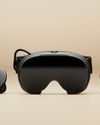कोशिश गोल्ड - मुक्त
QUANTUM LEAP FORWARD: TRANSMON QUBIT HITS MILESTONE
Techlife News
|July 12, 2025
Researchers at Finland’s Aalto University have set a new benchmark in quantum computing, achieving a transmon qubit coherence time of one millisecond, nearly doubling the previous record of 0.6 milliseconds.
-

Published in Nature Communications, the milestone, led by Ph.D. student Mikko Tuokkola under Dr. Yoshiki Sunada, marks a significant step toward practical quantum computers.
The team’s qubit, fabricated in Aalto’s Micronova cleanroom with superconducting film from VTT Technical Research Centre, maintained a median echo dephasing time of 0.5 milliseconds and a maximum of 1.057 milliseconds, surpassing prior benchmarks.
Coherence time, the duration a qubit retains its quantum state, is critical for error-free computations. Longer times allow more complex operations, reducing the need for resource-heavy error correction.
 The team’s success, part of Finland's Quantum Flagship initiative, used refined niobium patterning, precise Josephson junction fabrication, and a traveling-wave parametric amplifier to cut noise, boosting Finland's reputation as a quantum powerhouse. This achievement could slash the overhead for faulttolerant systems, bringing quantum computing closer to real-world use.
The team’s success, part of Finland's Quantum Flagship initiative, used refined niobium patterning, precise Josephson junction fabrication, and a traveling-wave parametric amplifier to cut noise, boosting Finland's reputation as a quantum powerhouse. This achievement could slash the overhead for faulttolerant systems, bringing quantum computing closer to real-world use.The breakthrough, detailed in an arXiv preprint, comes as the $45 billion quantum computing market grows 30% annually. While the millisecond mark is a leap, challenges like scaling to multi-qubit systems and maintaining consistency across batches remain, testing the path to practical applications. The Aalto team’s success hinges on meticulous engineering. Transmon qubits, a leading platform for superconducting quantum computers, typically suffer from decoherence caused by material defects and environmental noise. The researchers optimized their approach with a tantalum-based platform, replacing niobium to reduce surface losses, and used electron-beam lithography for precise Josephson junctions—tiny superconducting tunnels critical for qubit function. Annealed sapphire substrates further cut dielectric losses, ensuring cleaner signals.
यह कहानी Techlife News के July 12, 2025 संस्करण से ली गई है।
हजारों चुनिंदा प्रीमियम कहानियों और 10,000 से अधिक पत्रिकाओं और समाचार पत्रों तक पहुंचने के लिए मैगज़्टर गोल्ड की सदस्यता लें।
क्या आप पहले से ही ग्राहक हैं? साइन इन करें
Techlife News से और कहानियाँ
Techlife News
REPORT HIGHLIGHTS UNCERTAINTY AROUND RUMORED LINKS BETWEEN CHATGPT AND APPLE HEALTH
A recent wave of online speculation has suggested that Apple could be preparing deeper ties between ChatGPT and health-related features on its platforms, but new reporting indicates there is no clear evidence supporting those claims.
3 mins
December 06, 2025

Techlife News
APPLE RESTRUCTURES ITS AI LEADERSHIP AS JOHN GIANNANDREA PREPARES TO RETIRE
Apple has announced a major leadership transition within its artificial intelligence organization, confirming that John Giannandrea, who has overseen the company's Al strategy since 2018, will step down next spring.
4 mins
December 06, 2025

Techlife News
AIRBUS PREPARES SOFTWARE FIX AS FLIGHT OPERATIONS FACE NEW DISRUPTION RISK
Airbus is preparing to distribute a software update to airlines worldwide after carriers reported concerns about a digital monitoring tool used on multiple aircraft families, prompting the company to begin a coordinated response aimed at preventing potential delays.
4 mins
December 06, 2025

Techlife News
APPLE'S NEW AIRPODS FEATURES EXPAND PERSONAL AUDIO WITH ENHANCED CONTROL AND DEVICE-AWARE INTELLIGENCE
Apple has begun rolling out a fresh set of AirPods features that deepen the integration between its earbuds and the wider Apple ecosystem, giving users new interaction tools, improved situational awareness and expanded device-level functionality across iPhone, iPad and Mac.
3 mins
December 06, 2025

Techlife News
NETFLIX REMOVES MOBILE CASTING SUPPORT ON NEWER SMART TV MODELS
Netflix has begun phasing out mobile casting support on newer smart TV models, altering how users send content from their phones to the Netflix app on select televisions.
3 mins
December 06, 2025

Techlife News
VALVE'S LONG-RUNNING ARM BET PUTS STEAM ON A PATH TOWARD PHONES, TABLETS, AND NEW MOBILE HARDWARE
Valve's recent hardware announcements placed most of the public focus on the Steam Machine revival, but a quieter detail embedded in the company’s new standalone VR headset points toward a far broader shift.
5 mins
December 06, 2025

Techlife News
JENSEN HUANG'S WASHINGTON VISIT PUTS NVIDIA AT THE CENTER OF A SHARPENING AI POLICY DIVIDE
Nvidia CEO Jensen Huang met privately with President Donald Trump and Republican senators on Wednesday, stepping directly into an intensifying policy fight over U.S. leadership in artificial intelligence and the extent to which American chipmakers should be allowed to sell high-performance hardware abroad.
4 mins
December 06, 2025
Techlife News
NVIDIA'S $2 BILLION SYNOPSYS PARTNERSHIP EXPANDS ITS ROLE ACROSS THE SEMICONDUCTOR DESIGN STACK
NVIDIA has deepened its position inside the chip-design ecosystem through a new $2 billion partnership with Synopsys, a move that folds advanced GPU acceleration and Al-driven automation into the software tools used by semiconductor companies to create next-generation processors.
5 mins
December 06, 2025

Techlife News
NETFLIX PITCHES BUNDLE WITH HBO MAX AS “PRO-CONSUMER”
Netflix is telling regulators and counterparties that its proposed acquisition of Warner Bros Discovery's studios and streaming unit would lower streaming bills for many households by paving the way for a discounted Netflix-HBO Max bundle, according to people familiar with the talks.
5 mins
December 06, 2025

Techlife News
Netflix Rules
THE STREAMING PHENOMENON IS STILL NUMBER ONE WITH MUST-WATCH CONTENT
6 mins
December 06, 2025
Listen
Translate
Change font size
